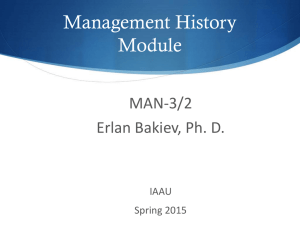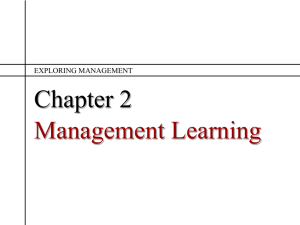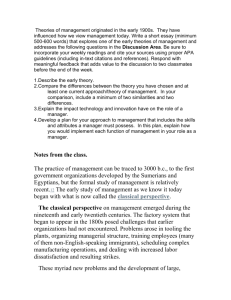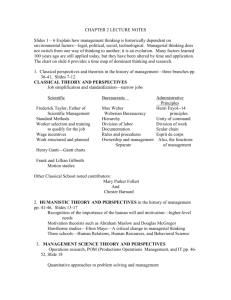CHAPTER 2
advertisement
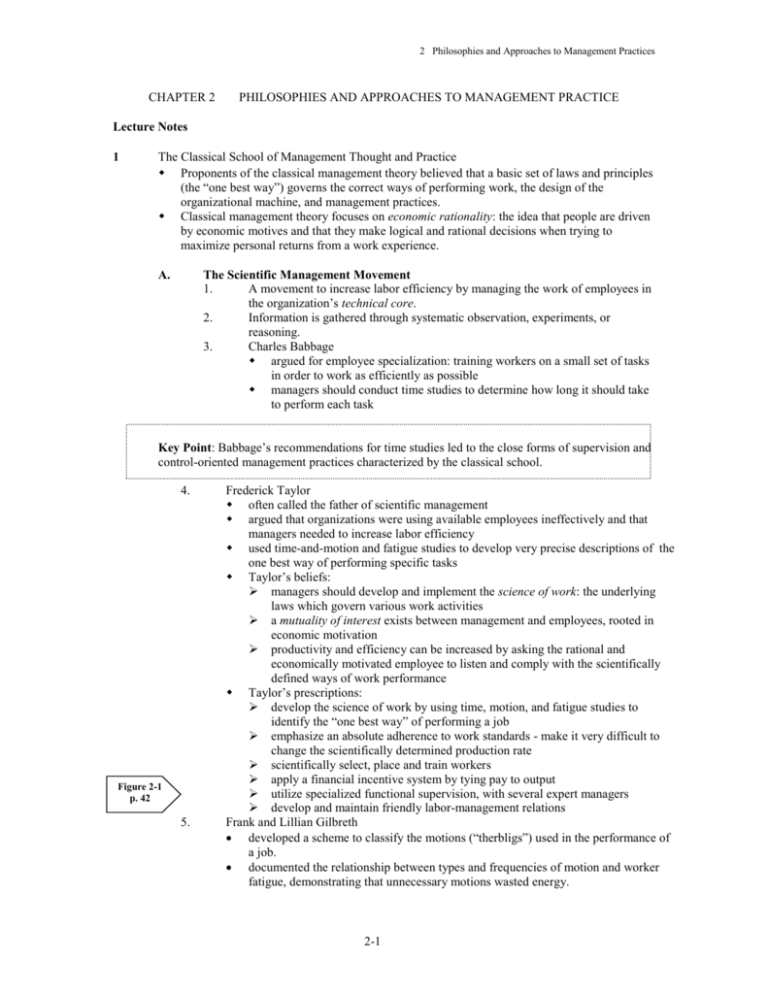
2 Philosophies and Approaches to Management Practices CHAPTER 2 PHILOSOPHIES AND APPROACHES TO MANAGEMENT PRACTICE Lecture Notes 1 The Classical School of Management Thought and Practice Proponents of the classical management theory believed that a basic set of laws and principles (the “one best way”) governs the correct ways of performing work, the design of the organizational machine, and management practices. Classical management theory focuses on economic rationality: the idea that people are driven by economic motives and that they make logical and rational decisions when trying to maximize personal returns from a work experience. A. The Scientific Management Movement 1. A movement to increase labor efficiency by managing the work of employees in the organization’s technical core. 2. Information is gathered through systematic observation, experiments, or reasoning. 3. Charles Babbage argued for employee specialization: training workers on a small set of tasks in order to work as efficiently as possible managers should conduct time studies to determine how long it should take to perform each task Key Point: Babbage’s recommendations for time studies led to the close forms of supervision and control-oriented management practices characterized by the classical school. 4. Figure 2-1 p. 42 5. Frederick Taylor often called the father of scientific management argued that organizations were using available employees ineffectively and that managers needed to increase labor efficiency used time-and-motion and fatigue studies to develop very precise descriptions of the one best way of performing specific tasks Taylor’s beliefs: managers should develop and implement the science of work: the underlying laws which govern various work activities a mutuality of interest exists between management and employees, rooted in economic motivation productivity and efficiency can be increased by asking the rational and economically motivated employee to listen and comply with the scientifically defined ways of work performance Taylor’s prescriptions: develop the science of work by using time, motion, and fatigue studies to identify the “one best way” of performing a job emphasize an absolute adherence to work standards - make it very difficult to change the scientifically determined production rate scientifically select, place and train workers apply a financial incentive system by tying pay to output utilize specialized functional supervision, with several expert managers develop and maintain friendly labor-management relations Frank and Lillian Gilbreth developed a scheme to classify the motions (“therbligs”) used in the performance of a job. documented the relationship between types and frequencies of motion and worker fatigue, demonstrating that unnecessary motions wasted energy. 2-1 2 Philosophies and Approaches to Management Practice 6. Figure 2-2 p. 44 B. the Gilbreths’ research helped make more of a worker’s energy available for job performance. Lillian Gilbreth pioneered modern human resource management, in particular the scientific selection, placement, and training of employees. Henry Gantt Added two techniques to scientific management: The Gantt Chart: a method of summarizing work activities and identifying those that should be performed simultaneously or sequentially. Minimum -wage-based incentive system minimum wage should be paid regardless of worker’s achievement of daily objectives bonuses should be given for work beyond the expected standard bonuses should be given to supervisors whose subordinates reach their daily standard Administrative Management and the Bureaucratic Organization 1. Concentrated on the management of an entire organization, not just the technical core. 2. Administrative Management and Henri Fayol attributed his success as a manager to his methods, not personal talent. Believed that other managers could be as successful if they had appropriate guidelines for managing complex organizations. recognized that the nature of managerial work differs from manager to manager according to such factors as the size of an organization and the manager’s location in the hierarchy. Fourteen Principles: division of labor: stressed importance of specialization authority: the right to give orders should always carry fitting responsibility discipline: respect for rules, policies, and agreements unity of command: each employee reports to one superior unity of direction: one manager for each organizational plan subordination of individual interest to the common good: needs of individual do not take precedence over the needs of the organization as a whole remuneration: equitable and satisfactory wages centralization: no level of centralization of decision-making is ideal for all situations scalar chain: exact lines of authority and relationships should be clear and followed at all times order: a place for everything; everything in its place equity: employees treated with kindness and justice stability of tenure: employee population should be stable initiative: subordinates should be encouraged to conceive and carry out their ideas esprit de corps: sense of teamwork should be fostered and maintained Key Point: Fayol felt that these principles should be flexible enough to match each organizational situation. He said, “seldom do we have to apply the same principle twice in identical condition; allowance must be made for different changing circumstances...” However, the practice of strictly applying these principles without allowing for flexibility characterizes the control-oriented approach to management that grows out of the classical school of management thought. 3. Table 2-1 p. 46 The Bureaucratic Organization and Max Weber the “architect of the bureaucratic organization” Weber envisioned an organization managed on an impersonal and rational basis. beliefs: labor should be divided according to specialization 2-2 2 Philosophies and Approaches to Management Practice C. Table 2-2 p. 48 2 authority and responsibility should be assigned to a position, not to an individual person organizations should have an elaborate set of rules specifying the rights and duties of employees and the procedures involved in each work situation written rules should govern all major activities; all management activities & decisions should be documented Contributions and Limitations of the Classical School 1. Classical management is prescriptive: it describes how people should manage an organization 2. The efforts of these researchers spurred additional scientific inquiry into management and organizational systems 3. Areas of disagreement supervision in the technical core: Fayol advocated unity of command; Taylor called for functional supervision putting principles into practice Fayol advocated flexible adherence to principles; in practice, classical management tended to be closed and rigid. Taylor advocated friendly labor-management relations; in practice, classical management was often cool, impersonal, and adversarial. 4. Criticisms description of employees as rational and economically motivated is incomplete, ignoring social needs of workers. ignoring social needs results in employees being treated as resources for economic ends, causing adversarial relationships between management and labor classical principles are not well-suited to shifting, heterogeneous environments Hawthorne Studies: A Transition in Thought and Practice A. Purpose 1. A series of worker productivity studies conducted 1924-1933. Focused on context in which employees performed their work 2. Strongly influenced the second school of management: behavioral management theory. 3. Provided a transition between the classical and behavioral management schools of thought. 4. Looked at relationship between worker productivity and illumination, length of breaks, length of workday, provisions for free lunches, and nature of pay plans. 5. The researchers expected that improvements in these environmental factors would improve productivity. B. Results 1. Results did not match expectations. 2. Sometimes productivity actually increased when decreases were expected, e.g., when lights were dimmed. 3. Researchers failed to find a simple relationship between work environment quality and productivity. Key Point: As a result of the Hawthorne Studies, the idea began to emerge that the employee was something other than a “rational and economic being”. 4. Interviews of subjects revealed that productivity increases were as much an outgrowth of group dynamics as of managerial demands, physical factors, and financial motives. Key Point: The behavioral norms established by informal work groups were found to be very powerful forces in determining employee productivity. Individuals producing above the 2-3 2 Philosophies and Approaches to Management Practice group’s norm were pressured by workers to slow down. Those who produced below the acceptable norm were pressured to speed up. 5. Following the Hawthorne Studies, a social model of employees was beginning to compete with the rational-economic model of the classical management school. An Inside Look: The Hawthorne Studies The importance of the Hawthorne experiments is a function of how researchers and scholars explained the unexpected findings. According to Elton Mayo: What actually happened was that six individuals became a team and the team gave itself wholeheartedly and spontaneously to cooperation in the experiment. They were happy in the knowledge that they were working without coercion from above or limitations from below. Mayo felt that the experiments satisfied worker’s needs and shifted their attention from personal problems to productivity. The major component of employees’ emotional condition was attitude toward supervisor. Productivity increased because being a part of the experiments made the workers feel important. Even members of control groups felt important; thus, their productivity was said to increase as a result. 3 The Behavioral School of Management Thought and Practice Members of the behavioral school of thought viewed organizations from a social and psychological perspective. Employees were seen as having a social need and a need to make a meaningful contribution. A. Early Contributors and Contributions 1. Robert Owen: called for treating workers with respect and dignity providing better working conditions reducing hours of work offering meals for the workforce restricting the use of children for labor 2. Hugo Munsterberg “the father of industrial psychology” applied psychological concepts to organizational setting documented psychological conditions associated with different productivity levels used psychological findings to match workers with jobs and motivate workers 3. Walter Dill Scott argued that if managers did not consider employees’ social needs, organizational effectiveness would be hindered managers do not place enough importance on employee selection and supervision managers should work at improving employee attitudes and motivation to increase productivity 4. Mary Parker Follett a manager’s influence and power should flow naturally from knowledge and skill managers should coordinate work activities through personal contact, not structured work systems or written rules 5. Chester Barnard made distinction between formal and informal organizations formal organization: an entity consciously created to achieve organizational goals informal organization: arises spontaneously as employees interact and form bonds 2-4 2 Philosophies and Approaches to Management Practice B. Figure 2-3 p. 53 C. identified the informal organization’s ability to aid communication, provide leadership, maintain cohesiveness, and strengthen individual feelings of integrity and self-respect The Human Relations Model 1. Portrayed the employee as a social being motivated by the need for recognition, acceptance, and inclusion. 2. Argued that satisfied workers would be productive workers. 3. Increases in worker productivity depend upon the degree to which an organization can meet workers’ needs for recognition, acceptance, and group membership. 4. Work-family programs have been implemented in many organizations as a result of this movement. The Behavioral Science Influence 1. Behavioral scientists stressed the need to conduct controlled studies of workers and their motivation, attitudes, and behavior. 2. Abraham Maslow: Need Hierarchy to motivate people, organizations must offer members the opportunity to satisfy their active personal needs identified the types of needs that employees have, the order in which employees are likely to satisfy their needs, and the actions that organizations must take to satisfy their needs. identified employees’ growth needs: the need for self-regard and the need to know and understand 3. Douglas McGregor: Theory X and Theory Y Theory X: traditional approach to management workers inherently dislike work, resists change, and are indifferent to organizational needs and goals managers must coerce, control, direct, and threaten workers with punishment to get them to put forth adequate effort Theory Y: workers like work, are motivated to achieve objectives to which they are committed, are capable of self-direction, and are only resistant to change when organizational and work-related experiences produce resistance. managers should create structures and processes that encourage employee involvement Self-Assessment, p. 55: Theory X and Theory Y Beliefs Key Point: McGregor and Maslow worked to show that employees are more complex than either the rational-economic model or the social model portrayed. They believed that employees have complex motivational patterns, and that behavior is strongly influenced by the need to exercise self-direction and self-control in pursuit of their full human potential. 4. 5. 6. Chris Argyris studied organizational and management systems’ effect on employees’ attitudes and behaviors the demands placed upon people by bureaucratic organizations are incompatible with the needs of a mature personality, as they deny people the opportunity to engage in independent thought and action advocated the development of open and flexible organizations which allow employees to exercise self-direction and self-control. Rensis Likert the most effective managers give their subordinates feelings of personal importance and self-worth more achievement and self-respect results from group participation in decision making and supervision Organizational Humanism concerned with employee satisfaction and well-being 2-5 2 Philosophies and Approaches to Management Practice 7. Figure 2-4 p. 58 D. Table 2-3 p. 60 called for employee participation in decision making studied the psychological forces that tie individuals to organizations, management of employee attitudes, motivation, and behaviors in the organization. interest in understanding the organization as a social system, the impact that organizations have on their members, motivation, attitudes, and behavior within the organization The Human Resource Model managers need to involve workers more in the affairs of the department employee involvement increases organizational performance because of the ideas and perspectives that they bring to decision making high involvement management functions are carried out by people at all levels and in all positions throughout the organization management achieves a fit among its people, tasks/technology, information processes, rewards, and organization structure requires providing employees with information, skills to perform, power to control and influence organizational events, and a reward system that shares organizational gains with members Contributions and Limitations of the Behavioral School 1. Contributions many of the ideas put forth by these scientists can be found in organizations today growth model of the employee: emphasized intrinsic rewards; drive for self-esteem and self efficacy led to less bureaucratization, more openness, flexibility, and employee involvement 2. Limitations uses jargon; lacks a good language for communicating the importance of its ideas to its managers behavioral scientists have not gotten the attention and respect of key managers in top positions many managers still view organizations as mechanical systems or in terms of financial bottom line behavioral theorists assume “one best way” to manage, allow for little deviation from this perspective An Inside Look: Partners in Beans The Philosophy of Starbucks Coffee includes fully involving employees in the company. Some examples: employees are called “partners” partners attend classes on customer service, brewing techniques, etc. after six months, partners are eligible for stock options employees participate in open forums to get information about company strategies self-managed work teams make decisions & control daily operations 4 Other Management Perspectives A. Figure 2-5 p. 62 Contingency Perspectives 1. The techniques appropriate for a manager to use depend on the situation. 2. As situations vary, the consequences of a particular approach to managerial duties also vary. 3. The resulting challenge facing management scientists is to identify, understand, and explain these critical contingencies. develop diagnostic skills to identify situational demands and characteristics 2-6 2 Philosophies and Approaches to Management Practice identify a management style appropriate for the demands of the situation develop the flexibility to move from one managerial style to another as needed Key Point: Throughout the book, contingency perspectives guide discussion of the management process from planning through controlling. B. The Total Quality Management Perspective 1. The goal of the quality management perspective is the achievement of customer satisfaction by providing high quality goods and services. 2. In TQM, the goal is an organization-wide commitment to quality continuous improvement attaining customer satisfaction by meeting or exceeding customer expectations 3. Pioneers of TQM: Deming, Juran, Ishikawa 4. The primary purpose of an organization is to stay in business so that the organization can promote the stability of the community in which it lives, provide products & services that are useful to its customers, and provide for the satisfaction and growth of its members. 5. Assumptions: it is less costly for an organization to turn out high quality than low quality products organizational members are naturally caring about the quality of their work organizations are made up of highly interdependent parts, so problems cut across functional lines quality and continuous improvement are the responsibilities of senior management the long-term health of an organization is dependent upon treating quality improvement as a never-ending process 6. Putting TQM into practice: goal setting training work incentives quality control departments quality control inspection locus of authority; responsibility for quality employee involvement performance appraisals employee communication intra-organizational competition C. The Systems Perspective 1. Systems theory is not a separate theory of management, but a way of viewing organizations. 2. The organization is a system that is made of interrelated elements, each functioning to contribute to the purpose of the whole. 3. If we want to understand the whole, we must understand the context in which the system is embedded, as well as the interrelationships that connect the parts to make up the whole. 4. Some systems perspectives the organization is part of and dependent upon a larger system (the external environment) the organization derives its inputs from the external environment, and transforms these inputs back into outputs that are exported back to the external environment the organization is a unified whole, yet it consists of a number of interrelated subsystems in order to understand the organization, one needs to understand the context within which it is embedded, its subsystems, and the way these subsystems are interconnected the activity of any part of the organization affects the entire system open organizations attempt to interact with the external environment and build it into their operations 2-7 2 Philosophies and Approaches to Management Practice 5. a feedback system communicates to each part of the organization information that is germane to subsequent input and transformation processes left unattended, there is a natural tendency for a system to run down, degenerate, and eventually die Prescriptions keep internal boundaries more open managers need to be sensitive to the needs of the environment as they take resources from it and interact with it D. The McKinsey 7-S Framework 1. Grounded in systems theory. 2. There are seven interdependent factors which must be managed harmoniously strategy: plans of action to reach goals structure: organizational design systems: procedures & processes staff: personnel groups style: modes of managerial behavior skills: personnel capabilities superordinate goals: shared values E. The Theory Z Perspective 1. Ouchi: offered Theory Z to integrate the merits of the Japanese and American management styles. 2. Theory Z is less a major theory of management than a set of organizational and management style characteristics. 3. Emphasizes long-term employment, decision-making, responsibility, evaluation & promotion, control, career paths, and concern for employees’ total life. 4. Identifies employees as a key component of organizational productivity and effectiveness; prescribes how employees “should be” managed Figure 2-6 p. 66 F. Contributions and Limitations of the Contemporary Schools 1. Contributions unified the classicist’s focus on technical core and behaviorists’ focus on social elements identified the interdependence of the organizational subsystems sensitized managers to the fact that no one set of management principles is appropriate in all situations 2. Limitations each perspective is more complex than classical or behavioral theory; more difficult and less likely to be used no contemporary management perspective has been thoroughly researched 2-8
